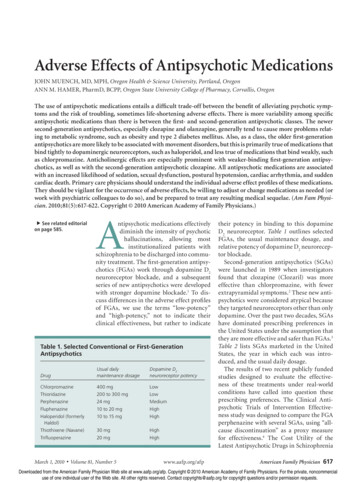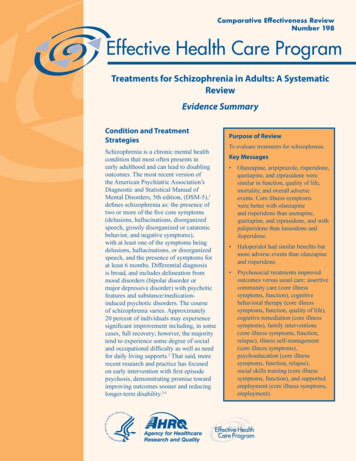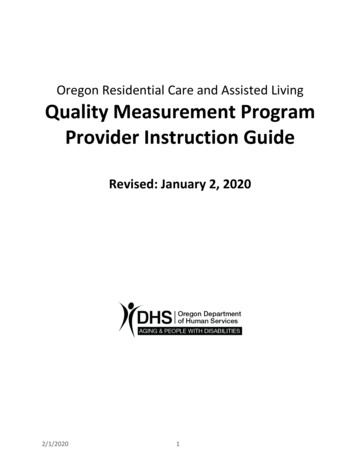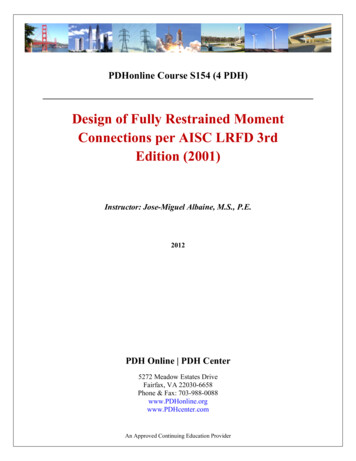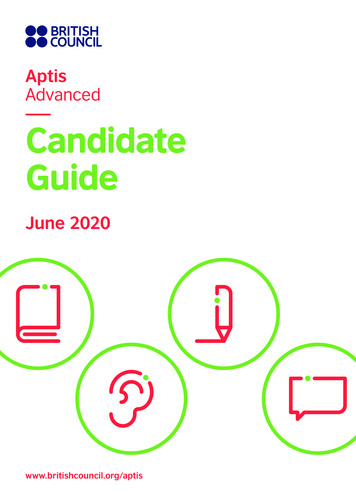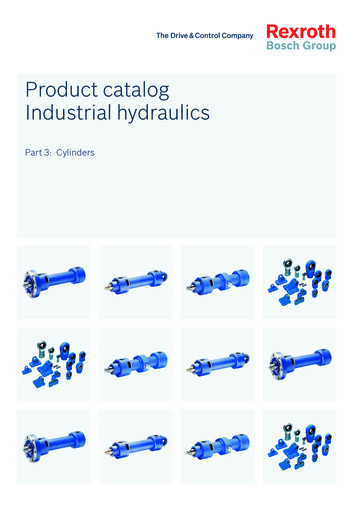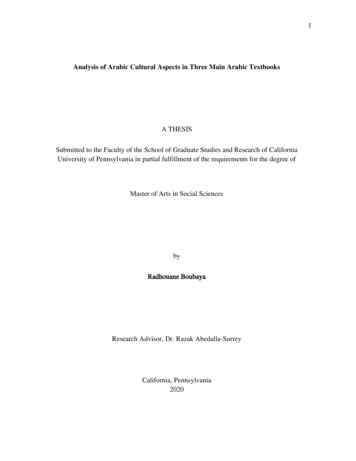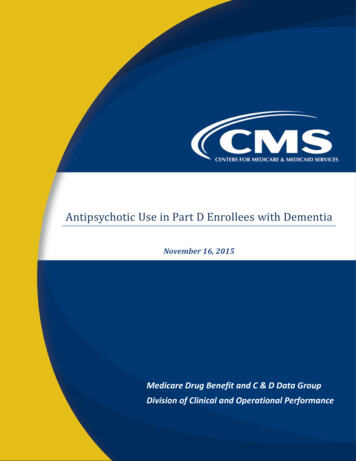
Transcription
Antipsychotic Use in Part D Enrollees with DementiaNovember 16, 2015Medicare Drug Benefit and C & D Data GroupDivision of Clinical and Operational Performance
Table of ContentsBackground . 3Objectives . 31.Verification of GAO’s Findings . 3Measure Specifications and Data Sources . 4Table 1: Data Source Comparison. 5Table 2. Multiple CMS Iterations: Diagnosis definition data source(s): . 5Table 3: Diagnosis Codes Included in Analysis . 6Table 4: Drug Product List . 6Nursing Home Stay Definitions . 7Key Findings . 7Table 5: GAO and CMS Comparable Results, Long-Term Nursing Home Residents . 8Table 6: GAO and CMS Comparable Results, Community-Only Population, 2012 . 8Conclusion . 82. Test and develop a new Part D measure based on the PQA measure, Antipsychotic Use in Personswith Dementia . 9Measure Specifications and Data Sources . 9Table 7: Data Sources for Diagnosis Information . 10Table 8: Diagnosis Codes Included in Analysis . 11Table 9: Dementia and Antipsychotic Medications . 11Table 10: Nursing Home Stay Definitions . 11Key Findings . 12Table 11. Antipsychotic Use in Beneficiaries Age 65 or Older with Dementia during 2013 . 12Table 12. Antipsychotic Use in Beneficiaries Age 65 or Older with Dementia during 2013, FrequencyDistributions and Statistics of Contract-Level APD Rates . 13Table 13. YOS 2013 Percentile Distribution of APD Rates among Contracts, All Beneficiaries Age 65or Older . 14Table 14: Distribution of Contract APD Rates by Low-Income Subsidy (LIS) Status . 14Table 15: APD Rates of Contracts with 30 Beneficiary-years . 15Conclusion . 15Appendix A. Reliability Testing. 16Appendix B. PQA Measures of Antipsychotic Use in Persons with Dementia . 17Antipsychotic Use in Persons with Dementia . 17Antipsychotic Use in Persons with Dementia – MDS. 192
BackgroundCMS has been particularly concerned with the unnecessary use of antipsychotic drugs in nursing homesand, as a result, has pursued strategies to increase awareness of antipsychotic use in long term care. In2013, we began to calculate a general atypical antipsychotic utilization rate, called Rate of Chronic Useof Atypical Antipsychotics by Elderly Beneficiaries in Nursing Homes, for inclusion in the 2013 Part Ddisplay measures using 2011 data. The average rates decreased from approximately 24.0% in 2011 to19.4% in 2014.There continues to be increased attention on this important issue. The United States GovernmentAccountability Office (GAO) released a report1 in January 2015 describing the inappropriate use ofantipsychotics in Part D beneficiaries with dementia, in both community (i.e., outside of nursing homes)and long-stay nursing home residents during 2012, with recommendations for CMS to address thisproblem. The GAO conducted this study due to concerns raised regarding the use of antipsychotic drugsto address the behavioral symptoms associated with dementia, the FDA’s boxed warning that thesedrugs may cause an increased risk of death when used by older adults with dementia, and the fact thatantipsychotic drugs are not approved for this use.In addition, the Pharmacy Quality Alliance (PQA) endorsed a new measure, Antipsychotic Use in Personswith Dementia (APD). This provides CMS with a new measure developed through a consensus processto monitor the inappropriate use of antipsychotics in both the nursing home and community settingsacross Medicare Part D plans.ObjectivesThe objectives of our analyses are to:1. Verify the GAO’s findings using a comparable methodology.2. Test and develop a new Part D measure based on the PQA measure, Antipsychotic Use inPersons with Dementia, with breakouts by nursing home and community settings, andsummarize the findings to potentially add to the Part D display measure set.1. Verification of GAO’s FindingsThe GAO reported that approximately 33 percent of older adult Medicare Part D enrollees withdementia who spent more than 100 days in a nursing home (defined as long-stay nursing homeresidents) in 2012 were prescribed an antipsychotic. Among Medicare Part D enrollees with dementiawho spent no time in a nursing home (community-only residents) that same year, about 14 percentwere prescribed an antipsychotic. GAO’s analysis of MDS data, regardless of enrollment in Part D,showed that approximately 30 percent of all older adult nursing home residents with a dementiadiagnosis were prescribed an antipsychotic drug at some point during their 2012 nursing home stay;23% for short-stay residents and 33% for long-stay residents.1Antipsychotic Drug Use: HHS Has Initiatives to Reduce Use among Older Adults in Nursing Homes, but ShouldExpand Efforts to Other Settings. http://www.gao.gov/products/GAO-15-211. GAO-15-211: Published: Jan 30,2015. Publicly Released: Mar 2, 20153
The GAO’s report methodology was as follows: To identify individuals living in nursing homes, Medicare Part D Prescription Drug Event (PDE)data were combined with 2012 data from the Long Term Care Minimum Data Set (MDS), whichincludes nursing home assessments for all individuals living in nursing homes, regardless ofinsurance coverage.Data from the Medicare Master Beneficiary Summary File (MBSF) and the Medicare Part D Risk(RAPS) file were used to identify diagnoses, including dementia and mental health diagnoses forwhich FDA has approved the use of antipsychotic drugs.Only those beneficiaries that survived through 2012 were included in order to exclude patientswho received antipsychotics within hospice or palliative settings at the end of life.Individuals with dementia also diagnosed with schizophrenia and bipolar disorder, which areFDA-approved conditions for antipsychotic drugs, were excluded.An individual was counted as an antipsychotic user if he/she was prescribed at least oneprescription for an antipsychotic drug during the year, regardless of the days supply of theprescription.The nursing home population was limited to beneficiaries with a long stay (i.e., more than 100days; Part A often covers prescriptions dispensed during stays less than 100 days) and Part Dprescription coverage.Antipsychotic prescription fills were identified in the PDE data using the relevant national drugcodes (NDCs) for antipsychotic drugs. NDCs were identified using the Red Book drug database.We approximated the findings of the 2015 GAO report on antipsychotic use in Part D patients withdementia during 2012 with support from our contractor, Acumen LLC, by replicating the methodsdescribed in the report as closely as possible. While some of the exact data sources and specificationsused by GAO are not available in the report, this analysis used multiple iterations of the same metricsbased on different data sources for identifying diagnoses to provide several points of comparison. This isdescribed in more detail below.Measure Specifications and Data SourcesTo parallel GAO’s analysis, our analysis excludes beneficiaries who: were younger than 65 (defined as those under the age of 65 as of 1/1/2012)had a dementia diagnosis and an exclusion diagnosis (Schizophrenia, Bipolar Disorders,Huntington’s disease, Tourette syndrome)2were enrolled in Part D for less than 12 months in 2012 (Part D enrollment limited to E, H, R, andS contracts)had a death date in 2012ever resided outside of the 50 states and D.C. in 20122Huntington’s disease and Tourette syndrome diagnoses are not available in the RAPS file, but are available in theCWF and MDS data. The GAO analysis may not exclude beneficiaries with these diagnoses if based only on theRAPS data.4
The GAO analysis additionally excludes beneficiaries who: did not have Medicare coverage prior to 1/1/2011had outlier data identification codes or other outlier dataThis analysis does not apply these restrictions.This analysis used the following specifications for the rate calculation:Denominator: All beneficiaries 65 and older with (i) a dementia diagnosis and (ii) no diagnosis ofSchizophrenia, Bipolar Disorders, Huntington’s disease, or Tourette syndrome.Numerator: All beneficiaries in the denominator population with at least one prescription forany antipsychotic medication with a date of service in 2012 (regardless of days supply).Table 1 compares the sources used by GAO and CMS for NDCs, drug claims, enrollment, diagnosis, andnursing home enrollment for year-of-service (YOS) 2012.Table 1: Data Source ComparisonData ElementDrugs (NDC)Drug claimsDiagnosesNursing Home EnrollmentMedicare EnrollmentGAOCMSRed BookMedi-Span/First DataBankPrescription Drug Event (PDE) DataRisk Adjustment Processing System (RAPS, Part D Risk File)Master Beneficiary Summary File (MBSF)* Common Working File (CWF) InpatientMinimum Data Set (MDS)(IP), Outpatient (OP), Carrier claimsMinimum Data Set (MDS)Master Beneficiary Summary File (MBSF)Common Medicare Environment (CME)* The MBSF uses the Chronic Condition Warehouse (CCW) as the source of diagnosis data. Managed care encounter data is notavailable in CCW for people enrolled in Medicare Advantage (MA) plans. Similarly, the CWF does not include outpatient orcarrier claims for MA-PDs.Table 2 lists the sources for diagnosis information used for each iteration performed for both dementiaand the mental health diagnoses, and the differences between these sources. All iterations providedfindings similar to the GAO’s; however, the Full CWF RAPS diagnosis definition analysis bestapproximated the GAO findings. Therefore, we selected the Full CWF RAPS diagnoses sources for ourfinal analysis.Table 2. Multiple CMS Iterations: Diagnosis definition data source(s):Data SourceDiagnoses Included1. RAPS OnlyPrescription Drug HierarchicalCondition Categories (RxHCCs)include prior year diagnoses only2. Full CWF RAPS3. Full CWF RAPS MDSCurrent year IP, OP, Carrier claims prior year RxHCCsCurrent year IP, OP, Carrier claims prior year RxHCCs MDS diagnosesCommentsAvailable for all contracts, diagnoses are based onprior year (i.e., 2013 RxHCCs based on 2012diagnoses). RAPS data is updated in late summerbased on diagnoses from the prior year.Same as above, OP and Carrier claims available forPDP contracts only.Same as above, MDS diagnosis included if diagnosisever present in an assessment during the year.5
Our analysis used the ICD-9 diagnoses codes (DGNs), RxHCCs, and MDS codes summarized in Table 3 toidentify beneficiaries with the conditions of interest. Specific diagnosis codes used in the GAO analysiswere not available in the report.Table 3: Diagnosis Codes Included in AnalysisDisease DiagnosesDementia DiagnosesAlzheimer’s DiseaseDementia, ExceptAlzheimer’s DiseaseParkinson’s DiseaseExclusion DiagnosesSchizophreniaBipolar DisordersHuntington's DiseaseTourette SyndromeCMS DiagnosesRxHCC Codes (per GAOReport)MDS Codes (per GAOReport)331290, 290.1x, 290.3,290.4x, 294.1, 294.2331.8254I4200 ALZHMR CD5576I4800 DMNT CDI5300 PRKNSN CD295.0x to 295.9x296.0x, 296.1x, 296.4xto 296.9x333.4307.2358I6000 SCHZOPRNIA CD59Not AvailableNot AvailableI5900 MNC DPRSNI5250 HNTGTN CDI5350 TOURT CDICD-9 Codes (per PQAspecifications)We created an NDC list based on the products specified in the GAO report. These products are includedin Table 4.Table 4: Drug Product ListGAO Product ListFirst generation (conventional)Second Generation (atypical)Chlorpromazine HydrochlorideAripiprazoleFluphenazine HydrochlorideAsenapineHaloperidol; Haloperidol LactateClozapineLoxapine Hydrochloride*; Loxapine SuccinateIloperidoneMesoridazine Besylate*Lurasidone HydrochlorideMolindone mozideQuetiapine FumaratePromazine Hydrochloride*RisperidoneThioridazine*; Thioridazine HydrochlorideZiprasidone HydrochlorideThiothixene; Thiothixene Hydrochloride*Trifluoperazine Hydrochloride*GAO reported that some of the included drugs from the Red Book have been discontinued, which may limit the drug claims forthese products.GAO’s analysis excluded NDCs with routes of administration other than oral or sublingual and NDCs thatcontain antipsychotic drugs but are not classified as antipsychotics according to the Red Book datasource. Our analysis did not apply these additional exclusions.6
Nursing Home Stay DefinitionsBoth the GAO and CMS analyses assessed antipsychotic use in persons with dementia across differentsettings, using the MDS data to identify nursing home residents. A beneficiary was considered a long-stay nursing home resident if he/she had a stay greaterthan 100 cumulative days in a nursing home during the year.Beneficiaries who spent less than or equal to 100 cumulative days in a nursing home wereconsidered short-stay nursing residents.Beneficiaries with zero days in a nursing home were defined as community-only residents.Each beneficiary was counted in only one category for the entire measurement period within a contractand not considered separately for time spent in different settings (e.g., a beneficiary who experiencedboth short-term and long-term nursing home stays was included only in the long-term APD rate).Key FindingsOverall, our analysis findings were similar to the GAO’s study and demonstrated similar trends. Bothstudies reported the same overall Medicare Part D APD rates for long-stay nursing home beneficiaries(33%, Table 5 below) and similar rates for community-only residents (14% vs. 15%, Table 6 below).GAO did not report a Medicare Part D APD rate for short-term nursing home stays because Part A oftencovers prescriptions during short-term nursing home stays. However, GAO’s analysis of MDS data,regardless of enrollment in Part D, showed that approximately 23% of short-stay nursing home residentswith a dementia diagnosis were prescribed an antipsychotic drug at some point during their 2012nursing home stay. Although we did not attempt to replicate GAO’s findings for all nursing homeresidents regardless of Part D coverage, our analysis demonstrated a short-term Medicare Part D APDrate of 21%.The key difference between the GAO analysis and ours is that we identified more beneficiaries withdementia as nursing home residents, and the GAO identified more as community-only residents. TheGAO identified 24% more beneficiaries in the community-only setting while the number of beneficiariesidentified with dementia and receiving an antipsychotic was only 11% higher. Therefore, our communityAPD rates were slightly higher (one percentage point) than the GAO’s, overall and by residentcharacteristics. However, the stratified nursing home resident population rates were the same in bothanalyses for most population characteristics. Stratified analysis found the following population ratedifferences: APD rates were 4-5 percentage points higher for males compared to female nursing homeresidents; on the other hand, in community-only residents, the APD rates for males were 3percentage points lower compared to females.APD rates decreased as age increased within the nursing home population. This trend wasreversed in the community-only setting and the rates were slightly higher in the CMS analysiscompared to the GAO report.The south region had the highest APD rates across all settings, with the greatest percentagepoint difference found among long-term nursing home residents in the south region comparedto other locations.7
Table 5: GAO and CMS Comparable Results, Long-Term Nursing Home ResidentsGAO Long-Term Nursing Home Residents*NumberPart D BeneficiariesNumber withPercent withwithoutwith Dementiaantipsychotic %Age75-8489,13151,01436%85 31%Census NortheastLocation South93,02652,93836%West32,90613,67929%* Diagnosis data sources: RAPS, MBSF, and MDS**Diagnosis data sources: Full CWF and RAPSCMS Long-Term Nursing Home Residents**NumberNumber withPercent withwithoutantipsychotic 36%34,43414,39529%Table 6: GAO and CMS Comparable Results, Community-Only Population, 2012GAO Community Only*NumberPart D BeneficiariesNumber withPercent withwithoutwith Dementiaantipsychotic 32812%Age75-84468,32373,17114%85 1614%Census NortheastLocation South384,80065,19615%West241,77139,86114%* Diagnosis data sources: RAPS, MBSF, and MDS**Diagnosis data sources: Full CWF and RAPSCMS Community Only**NumberNumber withPercent withwithoutantipsychotic 2,20216%184,57135,13616%ConclusionAlthough the actual number of beneficiaries identified as long-term nursing home and community-onlyresidents between the GAO and our study were different, the proportions of beneficiaries withdementia receiving an antipsychotic without an FDA-approved indication were either the same for longterm nursing home residents (33%) or slightly different for community only residents (GAO, 14% vs.CMS, 15%). Our study confirms the GAO’s findings.The differences in CMS and GAO findings are likely due to methodological choices that we made whentrying to match GAO’s specifications: Sources of enrollment information and application of population restrictions: The GAO usedMBSF and we used the CME for enrollment data. The GAO analysis excluded beneficiaries who8
did not have Medicare coverage prior to 1/1/2011 or had outlier data identification codes orother outlier data. Our analysis did not apply these restrictions.Sources of diagnoses data: The GAO analysis used RAPS data, MBSF, and MDS codes to identifydiagnoses, whereas our analysis used RAPS data and ICD-9 Codes available in the CWF.Huntington’s disease and Tourette syndrome diagnoses are not available in the RAPS file, butare available in the CWF and MDS data. The GAO analysis may not have excluded beneficiarieswith these diagnoses if based only on the RAPS data. This would have the greatest impact in theanalysis of the community-only population; GAO used MDS data to supplement the diagnoses ofnursing home residents. GAO also states that, as a result of using the Medicare Part D Risk File,their “diagnosis categories may be conservative estimates as they did not take into accountlonger-standing or newer diagnoses.”3Antipsychotic drug lists: GAO’s analysis excluded NDCs with routes of administration other thanoral or sublingual and NDCs that contain antipsychotic drugs but are not classified asantipsychotics according to the Red Book data source. Our analysis did not apply theseadditional exclusions and used Medi-Span and First DataBank for drug data.2. Test and develop a new Part D measure based on the PQA measure,Antipsychotic Use in Persons with DementiaThe PQA endorsed a new measure, Antipsychotic Use in Persons with Dementia (APD). We tested thismeasure based on the PQA specifications. In addition, given the different data sources available to CMS,we investigated alternative sources of diagnosis data and various definitions of nursing home stays. Wealso adjusted rates based on the number of months beneficiaries are enrolled in each Part D contract(i.e., the member-years adjustment).Measure Specifications and Data SourcesThe PQA APD measure specifications that we tested differed from the GAO’s as described below: 3The GAO included any prescription for an antipsychotic; whereas we required at least oneantipsychotic prescription and that the beneficiary received a total day’s supply of greater than30 days.The GAO used RAPS data from the Medicare Part D Risk File and the MBSF to identify diagnoseswithin the community-only population plus the addition of MDS diagnosis data for nursing homeresidents, whereas we used current diagnoses data from the CWF File supplemented with RAPSdata, and PDE data to identify beneficiaries actively treated for dementia.The GAO analyzed antipsychotic use in 2012 and our development of an APD measure used YOS2013 data.http://www.gao.gov/products/GAO-15-211. P. 35.9
All rate calculations use the following specifications from the PQA APD measure:Denominator: All beneficiaries 65 and older with either (i) a dementia diagnosis and/or (ii) twoor more prescription claims for a dementia drug (cholinesterase inhibitor or NMDA receptorantagonist) and a total day’s supply greater than 60 days.Numerator: All beneficiaries in the denominator population with (i) at least one antipsychoticmedication prescription and a total day’s supply greater than 30 days and (ii) no diagnosis ofschizophrenia, bipolar disorder, Huntington’s disease, or Tourette syndrome.The APD measure rate was calculated for all contracts, MA-PDs, PDPs, and at the individual contractlevel for all beneficiaries, community-only residents (never a nursing home resident), and both shortterm and long-term nursing home stay residents during 2013 that meet the inclusion and exclusioncriteria. We also reported the measure at each level by low-income subsidy (LIS) status (Yes or No).This analysis used the following sources for claims, enrollment, diagnosis, and nursing home residencydata from YOS 2013:-PDE ClaimsCMECWFRAPSMDSDiagnoses DataThe first step in this analysis was a comparison of methods for identifying the numerator anddenominator populations, using four different combinations of diagnosis data obtained from IP, OP, andcarrier claims from the CWF and RxHCCs from the RAPS. Table 7 below summarizes these definitions.Table 7: Data Sources for Diagnosis InformationData SourceDiagnoses IncludedCommentsPartial CWF - IP OnlyFull CWFCurrent year IP claims onlyCurrent year IP, OP, Carrier claimsRAPS OnlyRxHCCs include prior yeardiagnoses onlyFull CWF RAPSCurrent year IP, OP, Carrier claims prior year RxHCCsAvailable for both MA-PD and PDP contracts.OP and Carrier claims available for PDP contracts only.Available for all contracts, diagnoses are based onprior year (i.e., 2013 RxHCCs based on 2012diagnoses). RAPS data is updated in late summerbased on diagnoses from the prior year.OP and Carrier claims available for PDP contracts only.The choice of diagnosis source(s) had a significant impact on the APD rates; aggregate APD ratesdecreased as additional diagnoses sources were added. The additional data sources provided addedopportunities to identify the diagnoses of interest, particularly the exclusion diagnoses. To provide themost current diagnoses data available, the full CWF plus RAPS data sources were selected, whichresulted in APD rates approximately 30% lower than using solely inpatient data from the CWF. Weexpect the use of updated RAPS data in late summer when calculating the measure rates for the prioryear should account for missing outpatient or carrier claim diagnoses that are not captured in the CWFfor MA-PDs.10
Table 8 lists the specific ICD-9 DGNs for the combined full CWF and RAPS’ RxHCCs used to identifybeneficiaries with the conditions of interest.Table 8: Diagnosis Codes Included in AnalysisDisease DiagnosesDenominator Diagnoses (Inclusion)Alzheimer’s DiseaseDementia, Except Alzheimer’s DiseaseParkinson’s DiseaseNumerator Diagnoses (Exclusion)SchizophreniaBipolar DisordersHuntington's DiseaseTourette SyndromeICD-9 Codes (per PQA specifications)RxHCC Codes331290, 290.1x, 290.3, 290.4x, 294.1, 294.2331.82545576295.0x to 295.9x296.0x, 296.1x, 296.4x to 296.9x333.4307.235859Not AvailableNot AvailablePQA provided the list of drug products used in this analysis (Table 9).Table 9: Dementia and Antipsychotic MedicationsCholinesterase Inhibitor Medications and NMDA receptor antagonists donepezil galantamine rivastigmine memantineAntipsychotic Medications Aripiprazole Iloperidone Asenapine Loxapine Chlorpromazine Lurasidone Clozapine Olanzapine Fluphenazine Paliperidone Haloperidol Perphenazine neTrifluoperazineZiprasidoneNursing Home Stay DefinitionsThe second step in this analysis was to investigate multiple definitions of long-term institutional (nursinghome) stays based on the LTC MDS. Table 10 summarizes two nursing home stay definitions included inthe analysis. The Long-Term Institutional (LTI) flag, used in the current atypical antipsychotic Part D displaymeasure, is an existing indicator provided in the yearly RAPS data, based on MDS assessments. The MDS Cumulative 100 indicator is based on the specifications provided in the PQAAntipsychotic Use in Persons with Dementia using MDS Data measure and also constructeddirectly from the MDS data. The MDS Cumulative 100 indicator is also consistent with CMSdefinitions in other measures. Beneficiaries found in the MDS but who did not have greaterthan 100 cumulative MDS days were classified as nursing home short-stays.Table 10: Nursing Home Stay DefinitionsIndicatorRAPS LTIMDS Cumulative 100Definition of LTC Stay 90 days; Stay terminated after 14 days inCommunity 100 cumulative MDS daysUnit ofObservationAvailabilityMonthYearlyDayMonthly11
A positive indicator for either definition identifies beneficiaries as nursing home residents with longterm stays. We determined that generating the MDS indicator directly from the MDS data is a viablealternative to using the RAPS LTI indicator. The MDS’ daily indicator is more precise than the RAPSmonthly indicator and is available on a monthly basis while the RAPS LTI data is available only annually.Using the MDS Cumulative 100 criteria leverages these advantages, provides a large denominator file,and maintains consistency with the PQA Antipsychotic Use in Persons with Dementia - MDS Datameasure and prior CMS definitions of long- and short-term nursing home stays.For the final rate calculations, beneficiaries were assigned to different settings as defined below. Eachbeneficiary was counted in only one category for the entire measurement period within a contract, notconsidered separately for time spent in different settings (e.g., a beneficiary who experienced bothshort-term and long-term nursing home stays was included only in the long-term APD rate). A beneficiary was considered a long-stay nursing home resident if he/she had a stay greaterthan 100 cumulative days in a nursing home during the year.Beneficiaries who spent less than or equal to 100 cumulative days in a nursing home wereconsidered short-stay nursing residents.Beneficiaries with zero days in a nursing home were defined as community-only residents.Key FindingsAPD rates across all 2013 contracts, using full CWF diagnosis plus RAPS data and the MDS Cumulative 100 nursing home stay definition, and applying the member-years adjustment, appear in Table 11. Theoverall APD rate was 13.23%. For community-only residents, the APD rate was 10.5%. The APD rates forshort- and long-term stay nursing home residents were overall about 13.6% and 20.9%, respectively.Although the APD rates for MA-P
codes (NDCs) for antipsychotic drugs. NDCs were identified using the Red Book drug database. We approximated the findings of the 2015 GAO report on antipsychotic use in Part D patients with dementia during 2012 with support from our contractor, Acumen LLC, by replicating th
